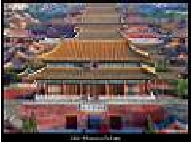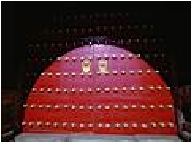|
 Lying
at the center of Beijing, the Forbidden City, called
gugong, in Chinese, used to be the imperial palace
of the Ming and Qing dynasties. It is called the
Palace Museum now. It lies 1 kilometer north of the
Tian’anmen Square, with its south gate, the Gate of
Devine Might (Shenwumen), facing the Jingshan Park.
960 meters long and 750 meters wide, the world
largest palace complex covers a floor space of
720,000 square meters, having 9,999 buildings. The
rectangular city is encircled in a 52-meter-long,
6-meter-deep moat and a 10-meter-high,
3,400-meter-long city wall which has one gate on
each side. There are four unique and delicate
structured corner towers overlooking the city inside
and outside on the four corners. Generally, it was
divided into two parts, the northern half, or the
Outer Court where emperors executed their supreme
power over the nation and the southern half, or the
Inner Court where they lived with their royal
family. Until 1924 when the last emperor in China
was driven out of the Inner Court, 14 emperors of
the Ming dynasty and 10 emperors of the Qing dynasty
had reigned here. About 500 years being the imperial
palace, it houses numerous rare treasures and
curiosities. It is now listed by the UN as World
Cultural Heritage in 1987 and is the hottest tourist
magnets. Lying
at the center of Beijing, the Forbidden City, called
gugong, in Chinese, used to be the imperial palace
of the Ming and Qing dynasties. It is called the
Palace Museum now. It lies 1 kilometer north of the
Tian’anmen Square, with its south gate, the Gate of
Devine Might (Shenwumen), facing the Jingshan Park.
960 meters long and 750 meters wide, the world
largest palace complex covers a floor space of
720,000 square meters, having 9,999 buildings. The
rectangular city is encircled in a 52-meter-long,
6-meter-deep moat and a 10-meter-high,
3,400-meter-long city wall which has one gate on
each side. There are four unique and delicate
structured corner towers overlooking the city inside
and outside on the four corners. Generally, it was
divided into two parts, the northern half, or the
Outer Court where emperors executed their supreme
power over the nation and the southern half, or the
Inner Court where they lived with their royal
family. Until 1924 when the last emperor in China
was driven out of the Inner Court, 14 emperors of
the Ming dynasty and 10 emperors of the Qing dynasty
had reigned here. About 500 years being the imperial
palace, it houses numerous rare treasures and
curiosities. It is now listed by the UN as World
Cultural Heritage in 1987 and is the hottest tourist
magnets.

Construction of the palace complex
started in 1407, the 5th year of the Yongle reign of
the third emperor of the Ming dynasty, and was
completed 14 years later in 1420. It was said that a
million workers including 100,000 artisans were
driven into the long-term hard labor. Stones needed
were quarried from Fangshan, suburb of Beijing. It
was said a well was dug along the road every 50
meters in order to pour water onto the road in
winter to slide huge stones on ice into the city.
Huge amount of timbers and other materials were all
freighted from faraway provinces. Ancient Chinese
people fully displayed their wisdom in building the
Forbidden City. Take the grand red city wall for
example, the ladder shaped wall has an 8.6 meters
wide bottom and a 6.66 meters wide top. The shape of
the city wall totally frustrate attempt to climb
onto the wall. The bricks of the wall are said made
from white lime and glutinous rice while the cement
is made from glutinous rice and egg whites, and
these incredible materials make the wall
extraordinarily strong. |